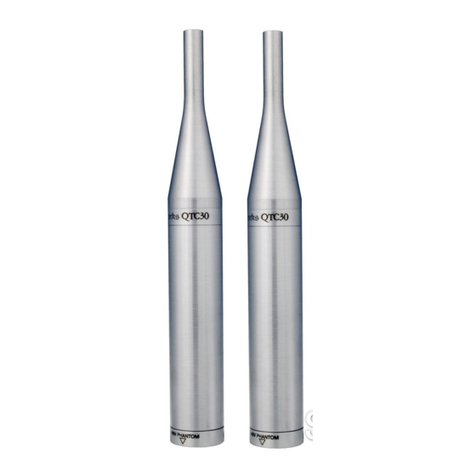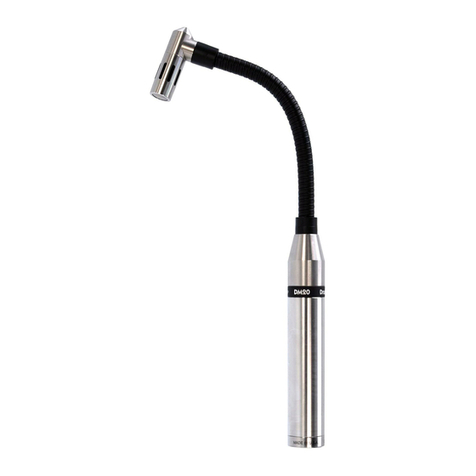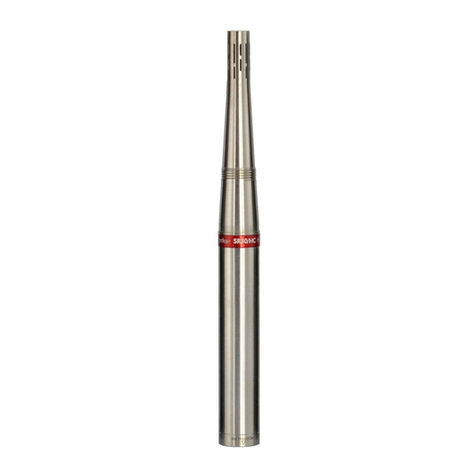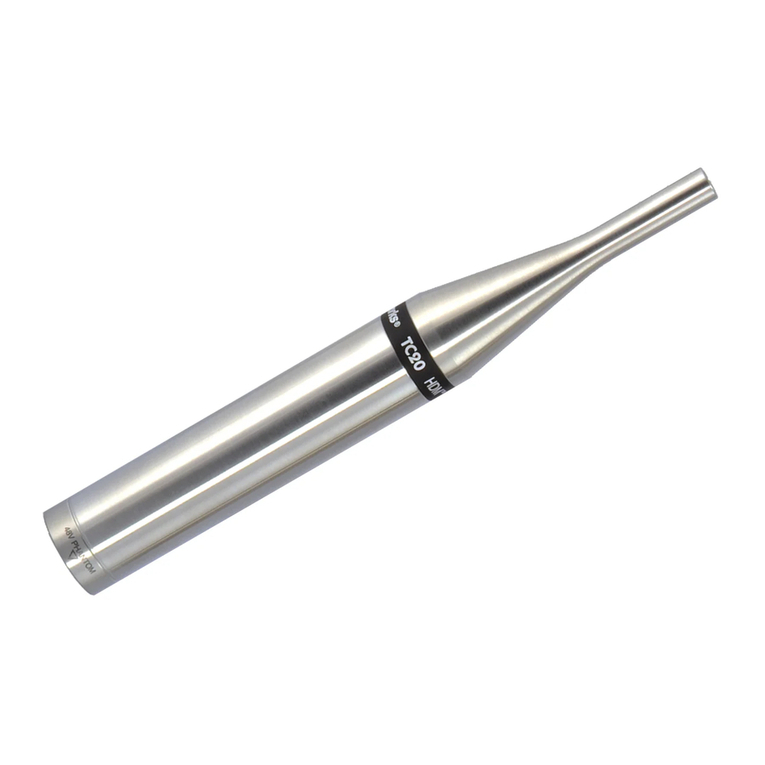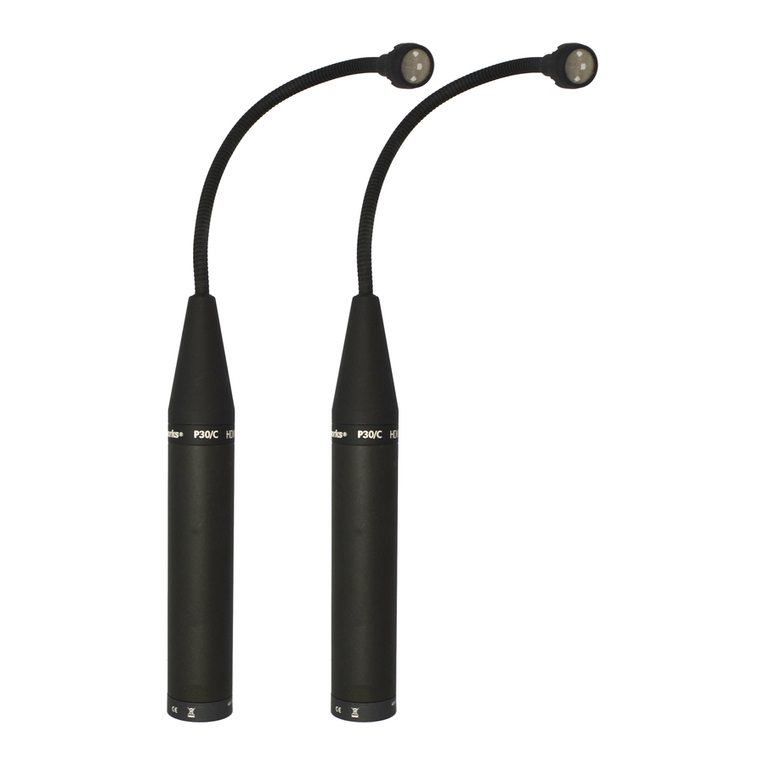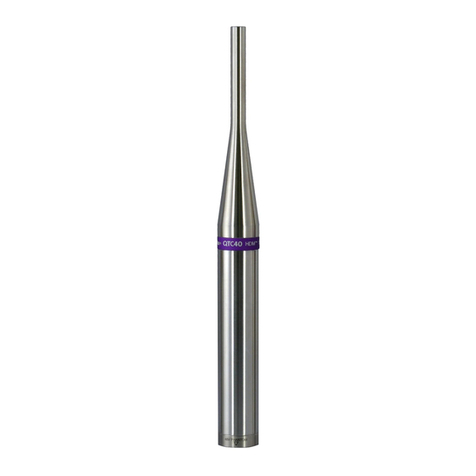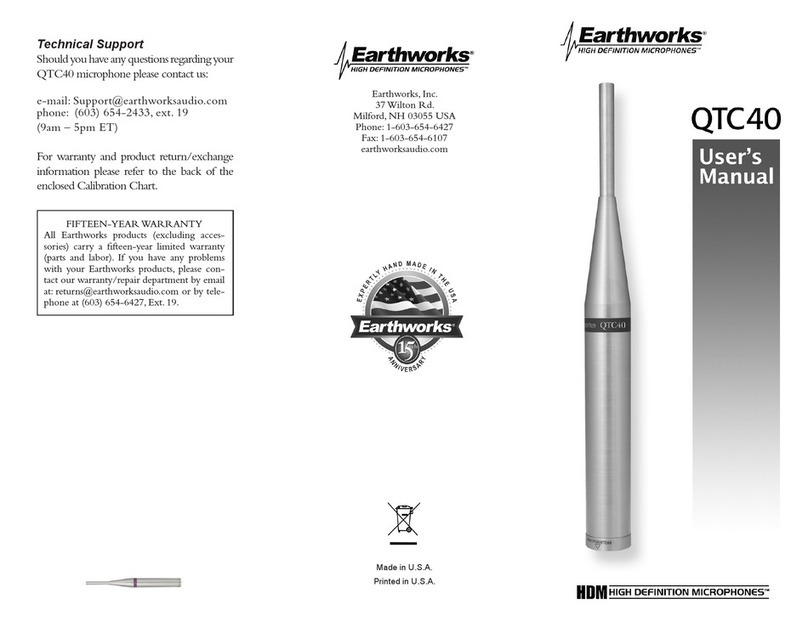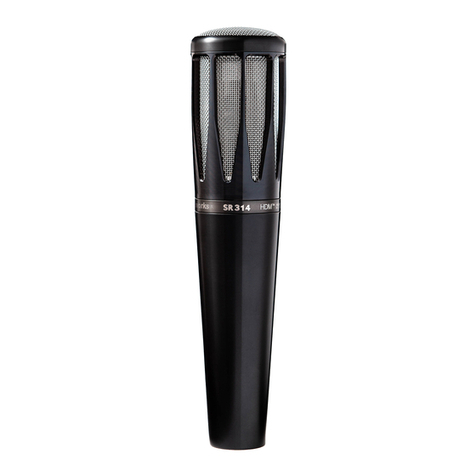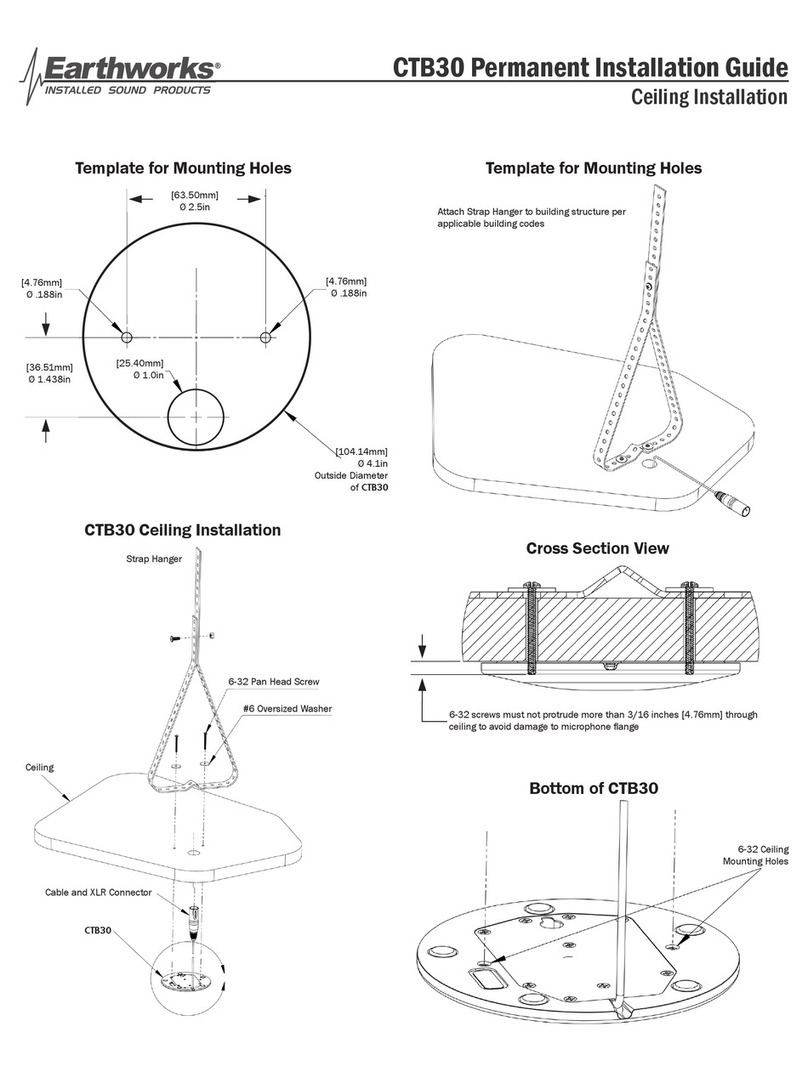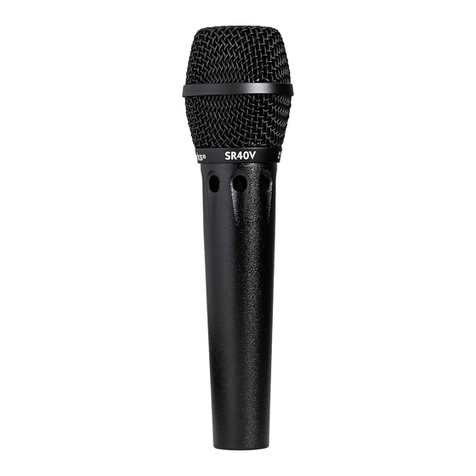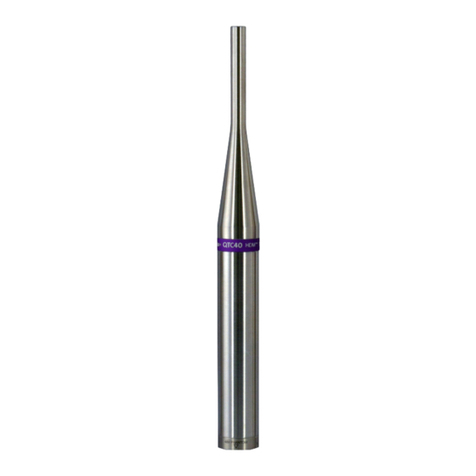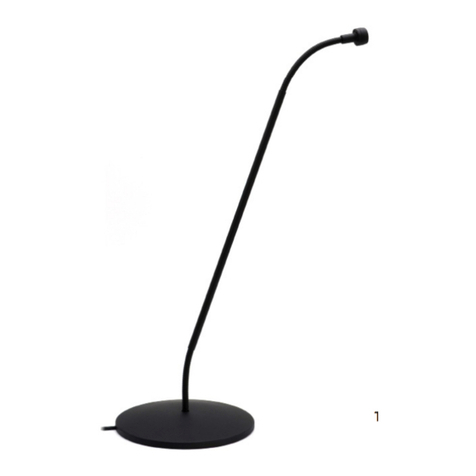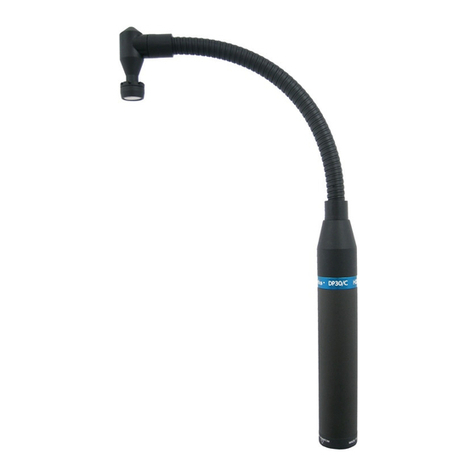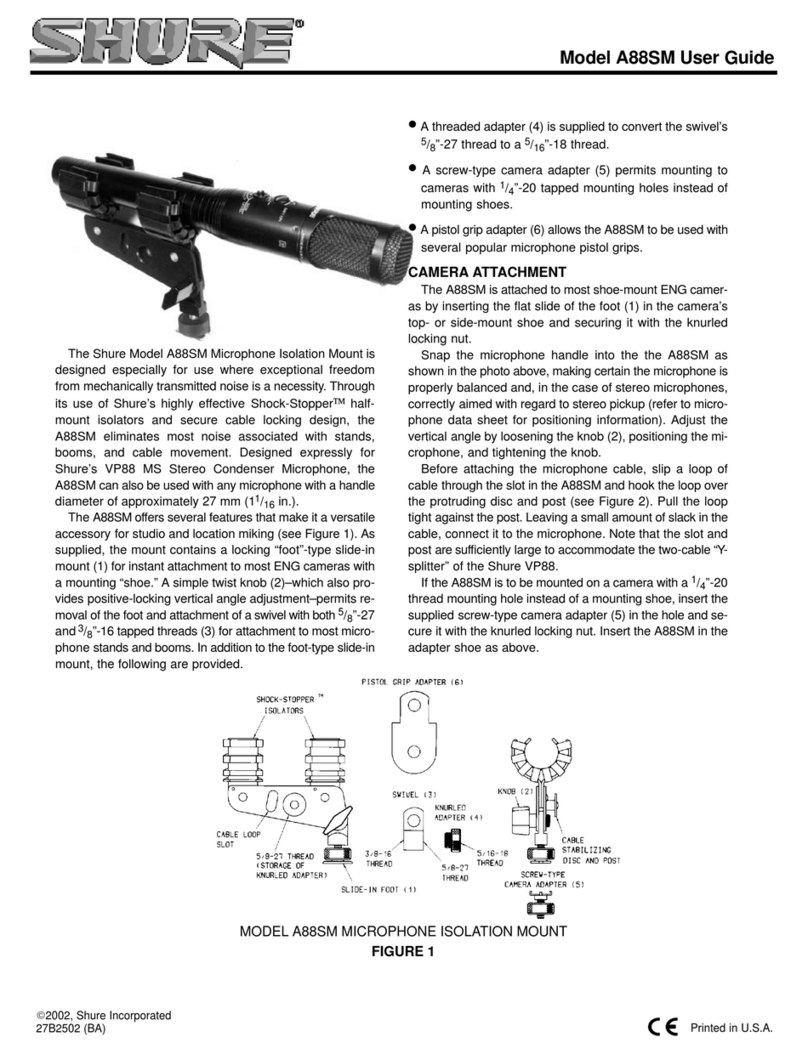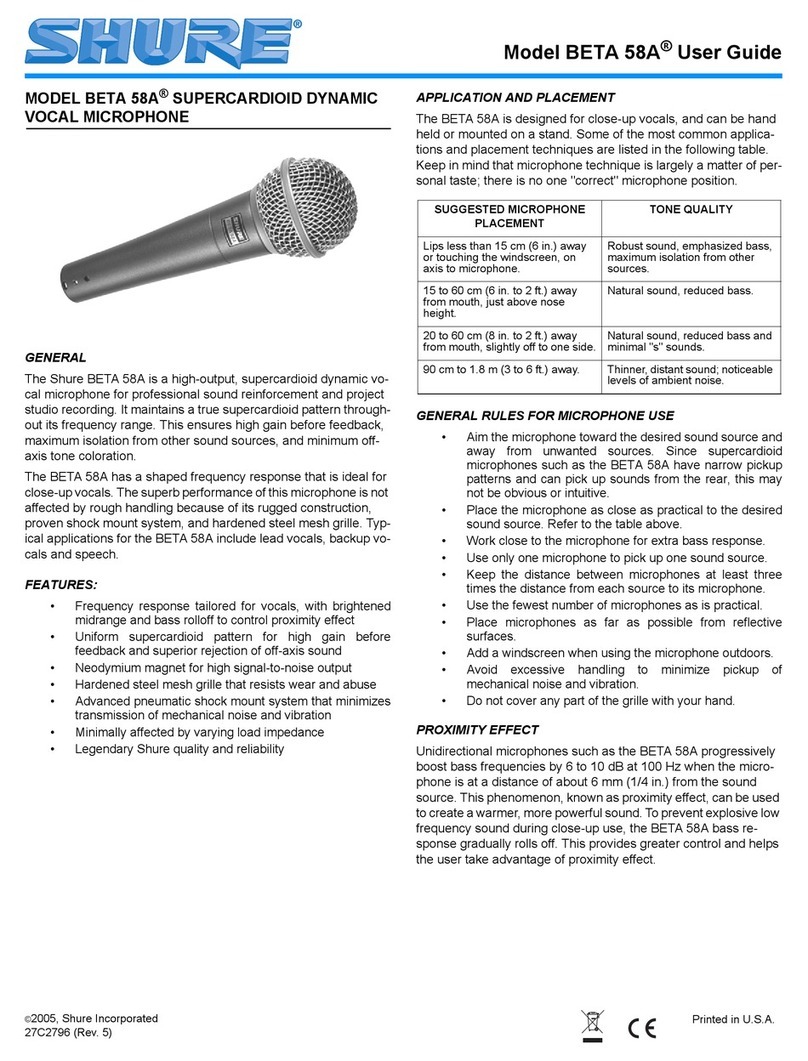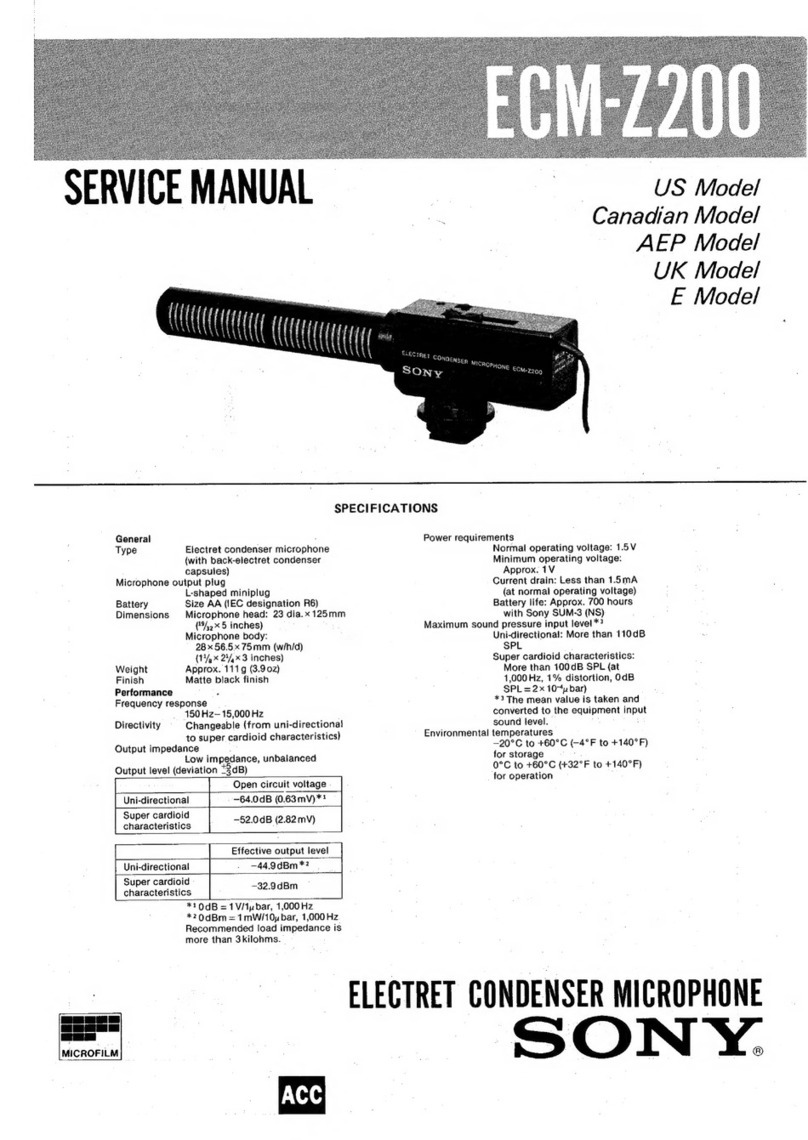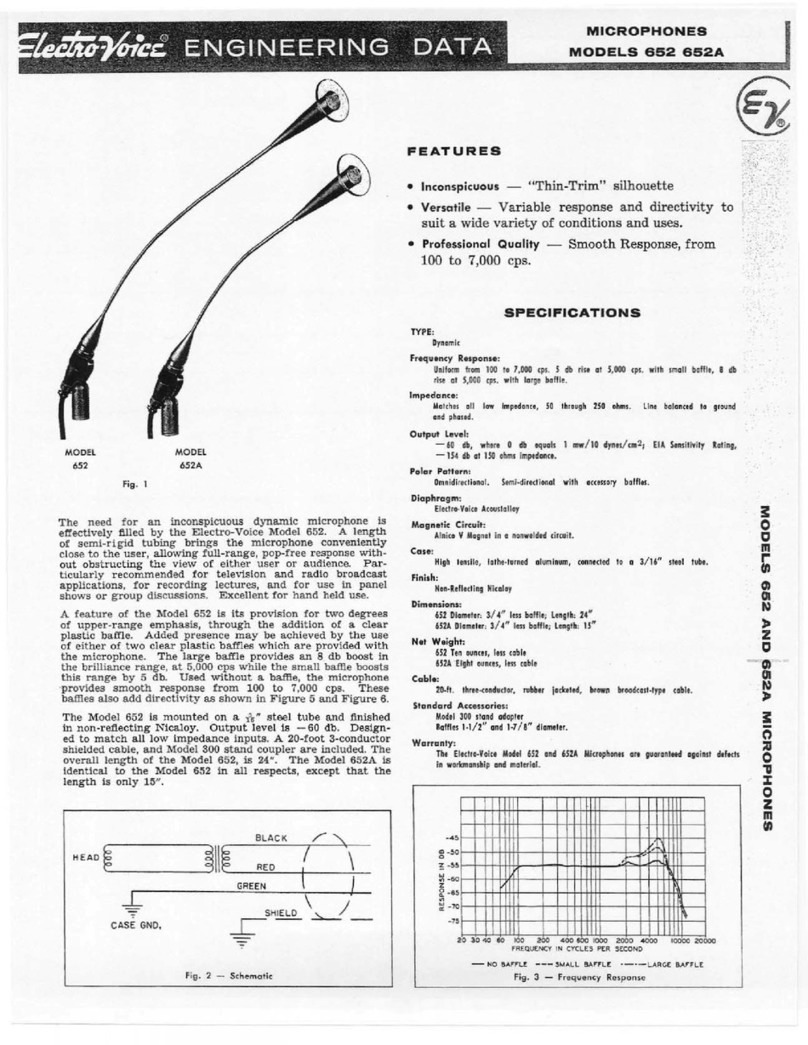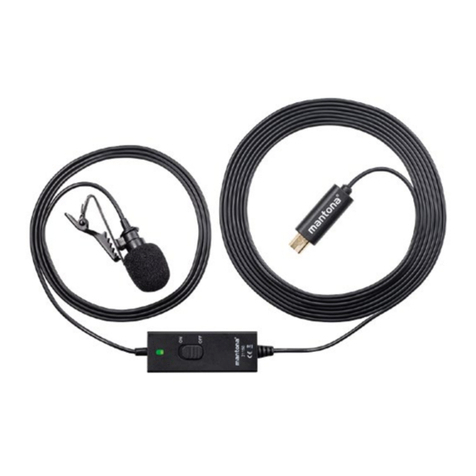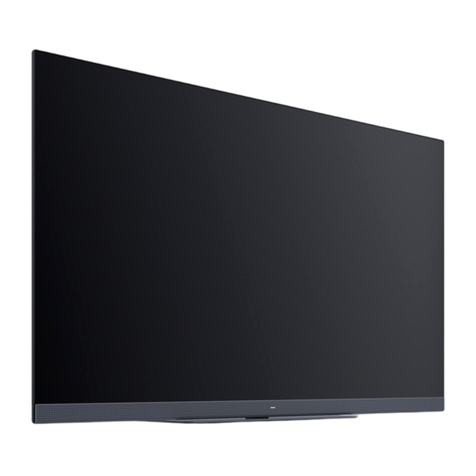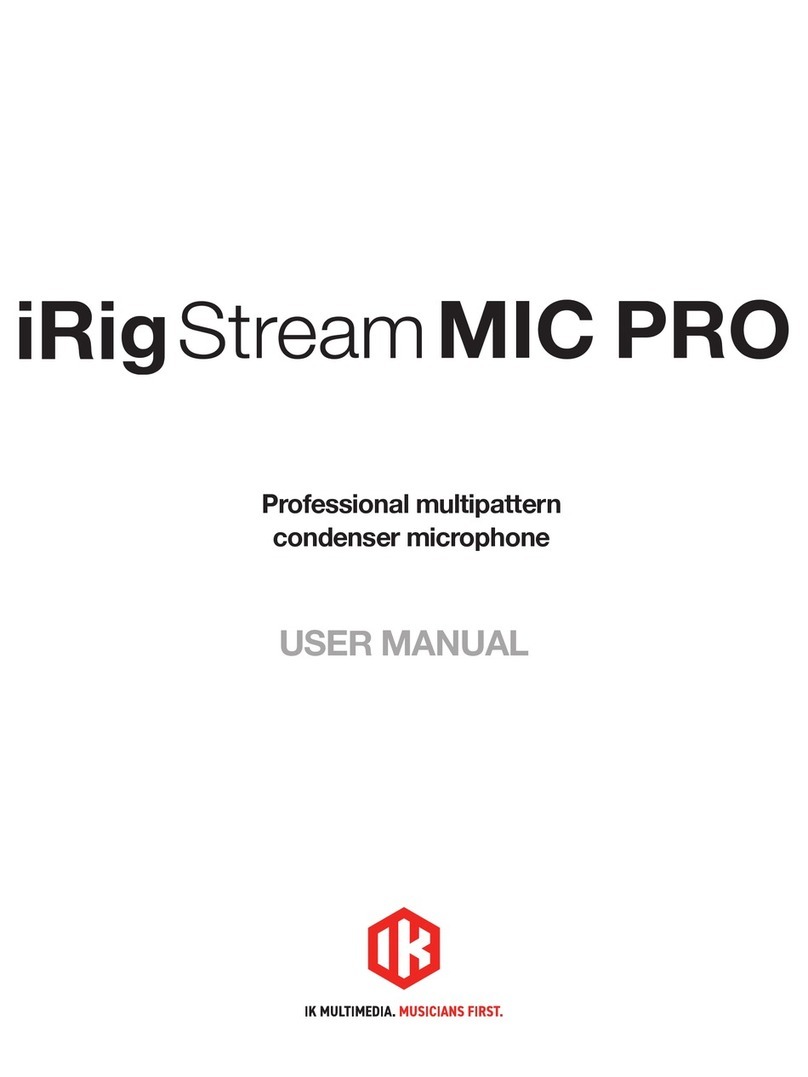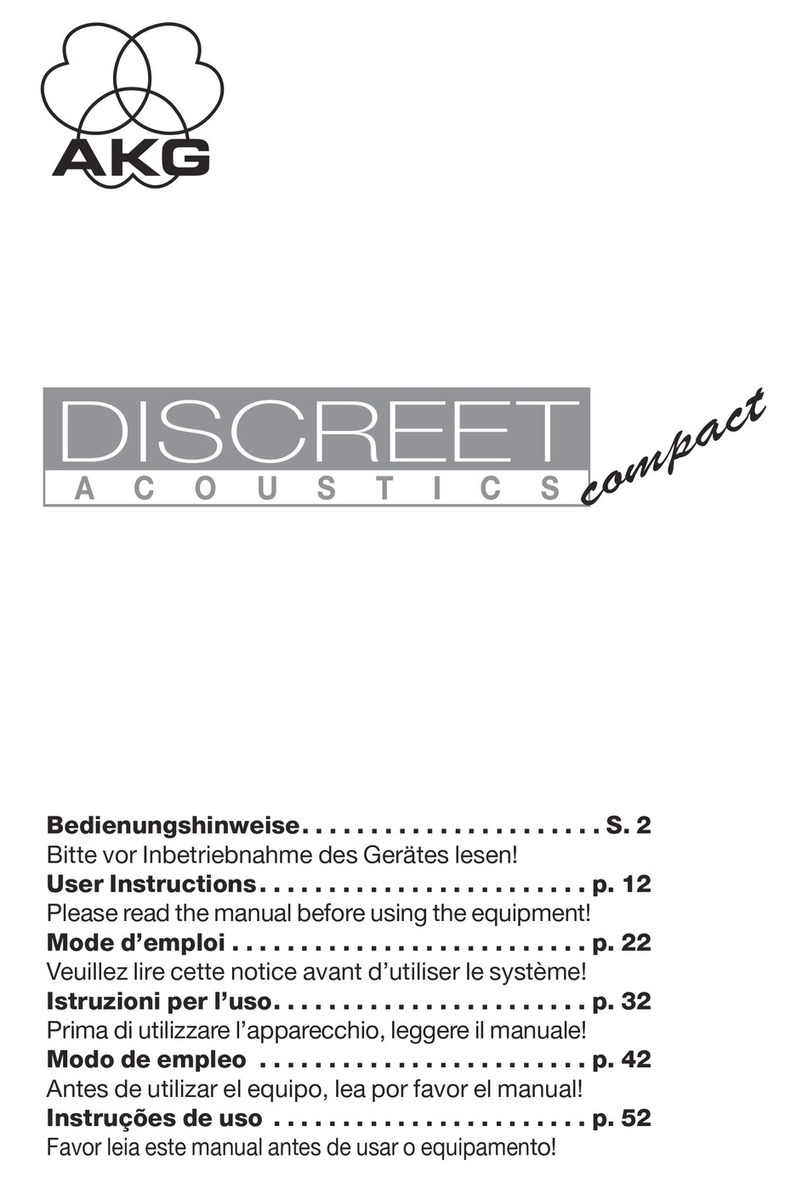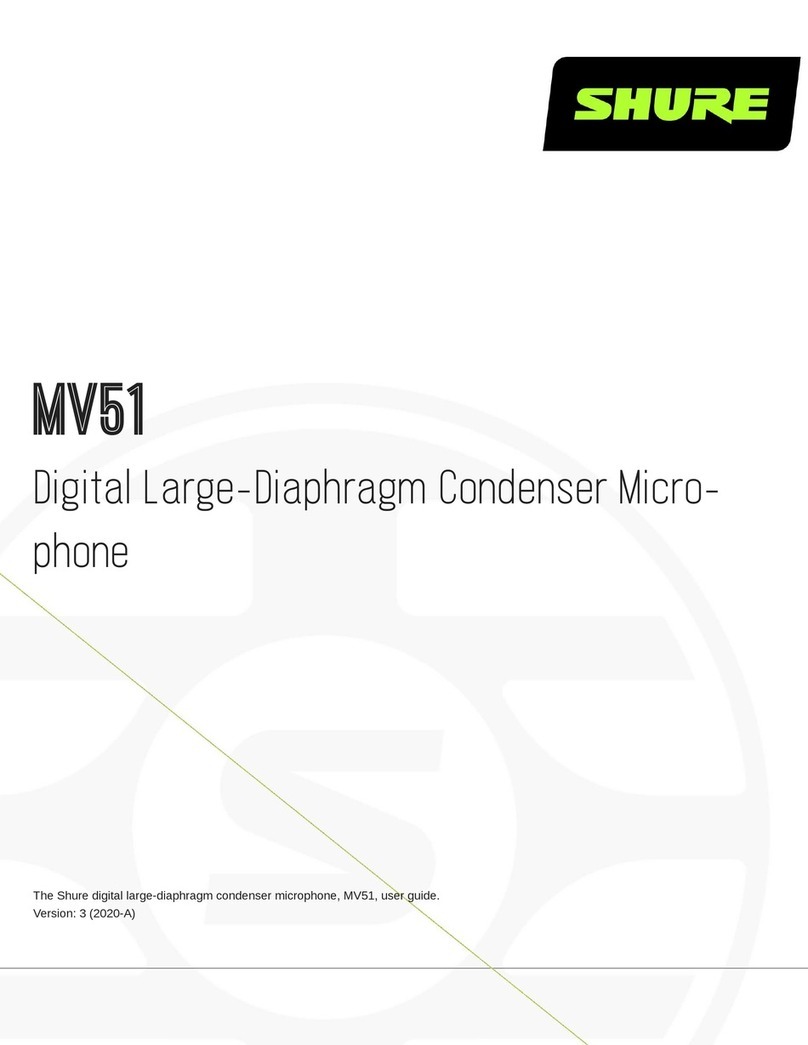SR20LS
Description
The Earthworks SR20LS is a cardioid condenser micro-
phone designed specically for kickdrum and other high
level acoustic sources up to 150dB SPL and requires stan-
dard 24-48V phantom power. It has a uniform frequency
response from 20Hz to 20kHz with a very fast impulse re-
sponse. The uncolored rear rejection of this microphone is
nearly twice that of conventional microphones.
Before You Start
After activating phantom power, allow up to a minute for
the SR20LS’s circuitry to settle. It is a good idea to keep
the channel muted during this settling time.
Important: Using the SR20LS for Kickdrum
Some popular kickdrum mics have built-in EQ for use on
kickdrum. However, such mics usually do not sound good
when miking other instruments or vocals. In contrast, the
SR20LS has an extended frequency response and a very
fast impulse response making it incredible for kickdrum.
It can also be used for miking most anything else. It has
no built-in EQ so you will need to EQ this mic for use with
kickdrum (see EQ and Signal Processing Section).
Miking the Front Head
When miking the kickdrum at the “front head” you can po-
sition the mic either at the edge or the center of the drum
head. However, do not place the microphone tip parallel to
the drum head as shown in Figure 1-A. Always place the
mic at an angle to the head (Figures 1-B & 1-C) to prevent
large bursts of air from pushing the diaphragm against its
backplate, which will create a “pop” or “snap” in the micro-
phone output signal.
Miking the Hole in the Head
First, make sure the mic clip is attached all the way at the
bottom (XLR end) of the microphone to allow it to go deep-
er inside the kickdrum (Figures 2-A & 2-B).
AB C
Figures 1-A, B & C Miking the Front Head
A
Figures 3-A & B High Air Velocity Close to Hole in Head
EQ and Signal Processing
It is standard practice when miking a kickdrum to EQ it by
boosting the low frequency range to make the kickdrum
sound fatter, and then boost the mid and/or high frequen-
cy range to hear more snap from the beater. However, you
may need to rethink this approach when using the SR20LS
with its extended low and high frequency response com-
pared to other mics used for kickdrum. This extended re-
sponse may reduce the amount of low and high frequency
EQ that would typically be used for kickdrum.
First, we suggest that you rst listen with the EQ “at” (Fig.
5) with all other signal processing turned “off.” You may be
surprised how good this mic sounds all by itself.
Next, before adding EQ or signal processing try moving the
mic around, whether placed inside or outside of the kick-
drum for the desired balance of beater sound and fat low
frequency kickdrum sound.
If EQ is needed, rst create a dip of -6 to -12dB at 500Hz.
Then if desired, add some high frequency “shelving” EQ
in the 2kHz to 3kHz range (Fig. 6) for the beater sound.
Next add some low frequency “shelving” EQ in the 60Hz to
80Hz range to fatten the low frequency sound if necessary
(Fig. 7). Play with the amount of EQ until you get the sound
you want. Keep in mind, all kickdrums sound different and
may require different amounts of EQ at slightly different
frequencies. For a simpler and easier EQ approach, you
can use an Earthworks KP1 KickPad™ that will do the ma-
jority of this EQ for you. Just plug this XLR type module into
the mic cable feeding your kick drum microphone.
It is also standard practice to sometimes use compres-
sion, limiting and/or gates (expanders) for kickdrum. It is
suggested that you rst obtain the EQ’d kickdrum sound
you want, then add compression, limiting and/or gating
until you obtain the desired kickdrum sound.
Many engineers using the SR20LS for kickdrum say it is
the best kickdrum mic they have ever used. We hope you
will nd this to be your favorite kickdrum mic as well.
Figure 5 Start with EQ “Flat”
+6dB
0dB
-6dB
10Hz 100Hz 1kHz 10kHz 20kHz
Figure 7 Add Shelving EQ in Low Frequency Range
10Hz 100Hz 1kHz 10kHz 20kHz
+6dB
+3dB
0dB
Figure 6 Add Shelving EQ in High Frequency Range
+6dB
+3dB
0dB10Hz 100Hz 1kHz 10kHz 20kHz
AB
Figures 4-A & B Suggested Miking inside Kickdrum
When miking the kickdrum at the hole in the head keep in
mind that the highest velocity of air from the hole is clos-
est to the outside or inside of the hole which could cause
the microphone to pop (Figures 3-A & 3-B).
Figure 2 Attach Mic Clip at XLR End of the Microphone
ABFor short mic stands with
boom parallel to oor
For taller mic stands with
angled boom
The mic will not go as far inside the kickdrum using a taller
mic stand (boom at an angle), than with a shorter mic
stand (boom parallel to the oor) see Figures 4-A & 4-B.
For optimum results place the microphone at least 6 inches
inside the hole (Figure 4-A) or closer to the batter head
(Figure 4-B). With the mic inside the kickdrum it should
be “placed at an angle” (mic tip not parallel to the head).
B
